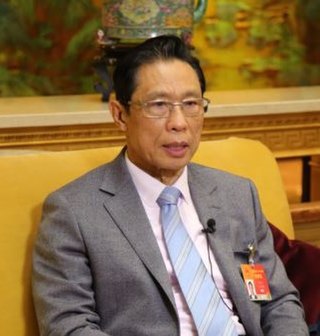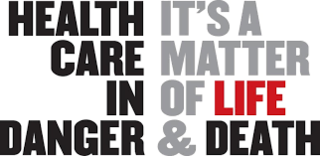
The healthcare industry is an aggregation and integration of sectors within the economic system that provides goods and services to treat patients with curative, preventive, rehabilitative, and palliative care. It encompasses the creation and commercialization of products and services conducive to the preservation and restoration of well-being. The contemporary healthcare sector comprises three fundamental facets, namely services, products, and finance. It can be further subdivided into numerous sectors and categories and relies on interdisciplinary teams of highly skilled professionals and paraprofessionals to address the healthcare requirements of both individuals and communities.

Mission Barrio Adentro is a Venezuelan social welfare program established by the President Hugo Chávez. Through Misión Barrio Adentro, Cuban doctors served Venezuelan communities where Venezuela's mostly white medical staff refused to work.
Physicians for Human Rights (PHR) is a US-based not-for-profit human rights NGO that uses medicine and science to document and advocate against mass atrocities and severe human rights violations around the world. PHR headquarters are in New York City, with offices in Boston, Washington, D.C., as well as Nairobi. It was established in 1986 to use the unique skills and credibility of health professionals to advocate for persecuted health workers, prevent torture, document mass atrocities, and hold those who violate human rights accountable.

Ashworth Hospital is a high-security psychiatric hospital in Maghull, 10 miles (16 km) northeast of Liverpool. It is a part of Mersey Care NHS Foundation Trust, catering to patients with psychiatric health needs that require treatment in conditions of high security.
Mental health in China is a growing issue. Experts have estimated that about 130 million adults living in China are suffering from a mental disorder. The desire to seek treatment is largely hindered by China's strict social norms, as well as religious and cultural beliefs regarding personal reputation and social harmony.
Fee-for-service (FFS) is a payment model where services are unbundled and paid for separately.
A health professional, healthcare professional, or healthcare worker is a provider of health care treatment and advice based on formal training and experience. The field includes those who work as a nurse, physician, physician assistant, registered dietitian, veterinarian, veterinary technician, optometrist, pharmacist, pharmacy technician, medical assistant, physical therapist, occupational therapist, dentist, midwife, psychologist, audiologist, or healthcare scientist, or who perform services in allied health professions. Experts in public health and community health are also health professionals.
The healthcare reform in China refers to the previous and ongoing healthcare system transition in modern China. China's government, specifically the National Health and Family Planning Commission, plays a leading role in these reforms. Reforms focus on establishing public medical insurance systems and enhancing public healthcare providers, the main component in China's healthcare system. In urban and rural areas, three government medical insurance systems—Urban Residents Basic Medical Insurance, Urban Employee Basic Medical Insurance, and the New Rural Co-operative Medical Scheme—cover almost everyone. Various public healthcare facilities, including county or city hospitals, community health centers, and township health centers, were founded to serve diverse needs. Current and future reforms are outlined in Healthy China 2030.

Healthcare in China has undergone basic changes over the twentieth century and twenty-first century, using both public and private medical institutions and insurance programs. As of 2020, about 95% of the population has at least basic health insurance coverage. Basic medical insurance includes two systems: employee medical insurance and resident medical insurance. The former covers the urban employed population, and the latter covers the urban non-employed population and the rural population. A total of 25% of the people covered by the basic medical insurance participated in the employee medical insurance, a total of 344 million people; 75% participated in the residents' medical insurance, a total of 1.017 billion people. Medical assistance has subsidized 78 million poor people to participate in basic medical insurance, and the coverage of poor people has stabilized at over 99.9%. Despite this, Public health insurance generally only covers about half of medical costs, with the proportion lower for serious or chronic illnesses. Under the "Healthy China 2020" initiative, China has undertaken an effort to cut healthcare costs, requiring insurance to cover 70% of costs by the end of 2018. In addition, there are policies such as critical illness insurance and medical assistance. China's commercial health insurance is also proliferating. In 2020, the country's commercial health insurance premium income amounted to 817.3 billion yuan, with an average annual growth rate of 20%. China's coverage of maternity insurance has continued to expand, by the end of 2020, 235.673 million people were insured under maternity insurance.

Iraq had developed a centralized free and universal healthcare system in the 1970s using a hospital based, capital-intensive model of curative care. The country depended on large-scale imports of medicines, medical equipment and even nurses, paid for with oil export income, according to a "Watching Brief" report issued jointly by the United Nations Children's Fund and the World Health Organization in July 2003. Unlike other poorer countries, which focused on mass health care using primary care practitioners, Iraq developed a Westernized system of sophisticated hospitals with advanced medical procedures, provided by specialist physicians. The UNICEF/WHO report noted that prior to 1990, 97 percent of the urban dwellers and 71 percent of the rural population had access to free primary health care; just 2 percent of hospital beds were privately managed.

A hospital is a healthcare institution providing patient treatment with specialized health science and auxiliary healthcare staff and medical equipment. The best-known type of hospital is the general hospital, which typically has an emergency department to treat urgent health problems ranging from fire and accident victims to a sudden illness. A district hospital typically is the major health care facility in its region, with many beds for intensive care and additional beds for patients who need long-term care.
Workplace safety in healthcare settings is similar to the workplace safety concerns in most occupations, but there are some unique risk factors, such as chemical exposures, and the distribution of injuries is somewhat different from the average of all occupations. Injuries to workers in healthcare settings usually involve overexertion or falling, such as strained muscles from lifting a patient or slipping on a wet floor. There is a higher than average risk of violence from other people, and a lower than average risk of transportation-related injuries.
Medical neutrality refers to a principle of noninterference with medical services in times of armed conflict and civil unrest: physicians must be allowed to care for the sick and wounded, and soldiers must receive care regardless of their political affiliations; all parties must refrain from attacking and misusing medical facilities, transport, and personnel. Concepts comprising the principles of medical neutrality derive from international human rights law, medical ethics and humanitarian law. Medical neutrality may be thought of as a kind of social contract that obligates societies to protect medical personnel in both times of war and peace, and obligates medical personnel to treat all individuals regardless of religion, race, ethnicity, or political affiliation. Violations of medical neutrality constitute crimes outlined in the Geneva Conventions.
Madwaleni Hospital is a Provincial government funded hospital near rural Elliotdale, Eastern Cape in South Africa.

Zhong Nanshan is a Chinese pulmonologist. He was president of the Chinese Medical Association from 2005 to 2009 and is currently the editor-in-chief of the Journal of Thoracic Disease. He is a recipient of Medal of the Republic, the highest honour of China.

Patient-initiated violence is a specific form of workplace violence that affects healthcare workers that is the result of verbal, physical, or emotional abuse from a patient or family members of whom they have assumed care. Nurses represent the highest percentage of affected workers; however, other roles include physicians, therapists, technicians, home care workers, and social workers. Non clinical workers are also assaulted, for example, security guards, cleaners, clerks, technicians. The Occupational Safety and Health Administration used 2013 Bureau of Labor Statistics and reported that healthcare workplace violence requiring days absent from work from patients represented 80% of cases. In 2014, a survey by the American Nurses Association of 3,765 nurses and nursing students found that 21% reported physical abuse, and over 50% reported verbal abuse within a 12-month period. Causes for patient outbursts vary, including psychiatric diagnosis, under the influence of drugs or alcohol, or subject to a long wait time. Certain areas are more at risk for this kind of violence including healthcare workers in psychiatric settings, emergency or critical care, or long-term care and dementia units.
Violence against healthcare professional has occurred in the form of physical violence, verbal abuse, aggressive gestures, blackmail, and cyber-bullying. Violence against doctors has been observed in the United States, Australia, India, China, Pakistan, Nepal, Sri Lanka and others.

The Beijing Xiaotangshan Recovery Hospital, also known as the Beijing Xiaotangshan Hospital, is a tertiary-level general hospital in Xiaotangshan Township, Changping District, Beijing, China, occupying approximately 33 hectares of land.
Becker's Hospital Review is a medical industry trade magazine that does its own research, supplementing this with government-released data and U.S. News & World Report rankings. It is published by ASC Communications, Inc., an Illinois corporation owned or controlled by its registered agent, Scott Becker, and lists with the Illinois Secretary of State its offices as being located at 77 W. Wacker Drive, Chicago, Illinois. It covers its field from the prospective of those involved: doctors, hospitals, and those who pay: patients and the general public. Some of these topics come together, such as a hospital's payout for disclosing a patient's HIV information to the person's employer, and reviewing how their privacy policy can accommodate the needs of hospital staff, those being treated, and the employer's insurance personnel.

Health Care In Danger is a campaign organized by the International Committee of the Red Cross that highlights violent attacks on patients, healthcare workers, and healthcare facilities in conflict zones.









